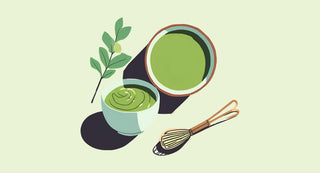For centuries, green tea has been celebrated for its health benefits and refreshing taste. Now, matcha, a vibrant green powder, has taken the spotlight, promising even greater advantages.
But what exactly is the difference between matcha and green tea, and which one is the better choice for you? In this guide, we’ll break down the differences between matcha vs. green tea for weight loss, caffeine content, health benefits, cholesterol, and taste—helping you decide which one suits your lifestyle best.
What is Matcha?
Matcha is a unique type of green tea made from the leaves of the Camellia sinensis plant. However, unlike traditional green tea, matcha is grown in the shade for about three weeks before harvest. This shading process increases the chlorophyll levels in the leaves, giving matcha its vibrant green color and boosting its amino acid content, particularly L-theanine. After harvest, the leaves are steamed, dried, and ground into a fine powder. This powder is then whisked into hot water to create a frothy, concentrated beverage. Unlike traditional green tea, where you steep and discard the leaves, matcha is fully consumed—making it more potent in antioxidants and nutrients. It originated in Japanese tea ceremonies and has since become a global superfood.
What is Green Tea?
Green tea also comes from the same plant, but it is typically grown in full sunlight. After harvesting, the leaves are quickly dried or steamed to prevent oxidation, preserving their natural catechins (antioxidants). This can involve steaming, pan-firing, or other methods, depending on the type of green tea. Unlike matcha, green tea is usually prepared by steeping the leaves in hot water and then removing them before drinking. There are many varieties of green tea, each with its own distinct flavor profile.
Key Differences: Matcha Vs. Green Tea
While both matcha and green tea come from the same plant, there are several key differences between them:
| Factor | Matcha | Green Tea |
| Processing | Shade-grown, stone-ground into powder | Sun-grown, whole or cut leaves |
| Preparation | Whisked into water | Steeped and strained |
| Taste | Creamy, umami, slightly bitter | Light, floral, or grassy |
| Caffeine Content | 38-176 mg per serving | 20-35 mg per cup |
| Antioxidant Levels | 3x higher (entire leaf consumed) | Moderate (steeped water only) |
| Weight Loss Benefits | Higher EGCG for fat burning & metabolism | Good but lower in EGCG |
| Heart Health & Cholesterol | Helps reduce LDL (bad cholesterol) | Supports cardiovascular health |
- Cultivation: Matcha is shade-grown, while green tea is typically sun-grown.
- Processing: Matcha leaves are ground into a fine powder, while green tea leaves are left whole or cut.
- Preparation: Matcha powder is whisked directly into water, while green tea leaves are steeped in water and then removed.
- Consumption: With matcha, you consume the entire leaf, while with green tea, you only consume the infused water.
- Taste Profile: Matcha has a vegetal, slightly bitter, and umami taste, while green tea can range from grassy and floral to nutty and astringent.
Matcha vs. Green Tea for Weight Loss
Both matcha and green tea contain catechins, especially EGCG (Epigallocatechin Gallate), which can enhance metabolism and increase fat burning.
- Matcha contains up to 3x more EGCG than regular green tea because you consume the entire leaf rather than just infused water.
- A study suggests matcha burns fat 25% more effectively than traditional green tea.
- Both are excellent choices, but matcha may give faster results when paired with a healthy diet and exercise.
Matcha vs. Green Tea Caffeine: Which One Gives More Energy?
If you're looking for a gentle energy boost without jitters, matcha is the winner.
| Drink | Caffeine (mg per cup) | Effect |
| Matcha | 38-176 mg | Sustained energy boost, no crash due to L-theanine |
| Green Tea | 20-35 mg | Gentle energy boost, lighter caffeine hit |
| Coffee | 95-200 mg | Fast energy spike, possible jitters & crash |
Matcha generally has a higher caffeine content than green tea. This is because you are consuming the entire leaf, resulting in a more concentrated dose of caffeine. The caffeine content in matcha can range from 38-176 mg per serving, while green tea typically contains 20-35 mg of caffeine per cup. However, the presence of L-theanine in matcha helps to mitigate the negative side effects of caffeine, providing a more balanced and sustained energy boost.
So, Matcha Vs. Coffee: Which One Should You Choose?
Looking for a caffeine alternative? Here's why matcha is a better choice than coffee:
☕ Coffee = Quick energy spike → Jitters → Energy crash
🍵 Matcha = Steady energy boost → No crash → Increased focus
Matcha also contains:
- More antioxidants than coffee
- Supports digestion and hydration (unlike coffee, which may cause acidity)
- Boosts metabolism for weight loss
💡 Why matcha over coffee? The presence of L-theanine in matcha ensures a calm yet focused energy boost, unlike the quick spike-and-crash of coffee.
Other Health Benefits
Both matcha and green tea are packed with antioxidants and other beneficial compounds, but matcha offers a more concentrated dose due to the consumption of the entire leaf.
Antioxidants:
Matcha is exceptionally high in catechins, particularly epigallocatechin gallate (EGCG), a potent antioxidant with numerous health benefits. Green tea also contains catechins, but in lower concentrations. Antioxidants help reduce inflammation, boost immunity, and slow down ageing.
Mental Focus & Stress Reduction:
Both matcha and green tea contain L-theanine, an amino acid that promotes relaxation and mental clarity. Thanks to L-theanine, matcha promotes calm alertness, improved focus, and reduced anxiety—making it a great alternative to coffee.
Studies have shown that regular consumption of matcha could improve emotional perception and sleep quality in older adults with mild cognitive decline. The combination of L-theanine and caffeine in matcha provides a calm, sustained energy boost without the jitters associated with coffee.
Heart Health & Cholesterol:
Regular consumption of green tea has been linked to a lower risk of heart disease. Matcha's higher antioxidant content may offer even stronger protection against cardiovascular issues. Both matcha and green tea have been linked to lower LDL cholesterol and better heart health. Matcha’s higher antioxidant levels may offer greater protection against cardiovascular diseases.
Detox & Digestion:
Matcha’s higher chlorophyll content supports natural detox, while green tea helps with digestion and metabolism.
Popular Questions
Which is better for daily consumption, green tea or matcha?
It depends on your individual preferences and health goals. Matcha offers a higher concentration of nutrients and a more sustained energy boost, while green tea is a good, more accessible option.
Can I replace green tea with matcha?
Yes, but consider the higher caffeine content and cost.
How many cups of green tea is matcha equivalent to?
Nutritionally, one cup of matcha can be equivalent to up to 3 - 10 cups of brewed green tea.
Is matcha the healthiest drink in the world?
While it has many benefits, no single drink is the "healthiest." A balanced diet is key.
How to Make Matcha Green Tea

- Sift 1/4 teaspoon of matcha powder into a bowl.
- Add 2-3 ounces of hot (not boiling) water.
- Whisk briskly with a bamboo whisk in a "W" or "M" shape until frothy.
- Enjoy as-is, or add honey, lemon, or plant-based milk for extra flavor.
Final Verdict: Which One Should You Choose?
✅ Choose Matcha if you want:
✔ A higher antioxidant boost ✔ More energy without jitters ✔ Faster weight loss benefits
✅ Choose Green tea if you prefer:
✔ A lighter taste ✔ Lower caffeine for easy daily consumption ✔ A budget-friendly health drink
Both are excellent choices for a healthy lifestyle. Try both and see which one fits your routine best! Matcha offers a more concentrated dose of nutrients and a unique taste experience, while green tea is a more accessible and versatile option.







